CATHEDRAL QUEST
Our quest to experience the great cathedrals and churches of Europe
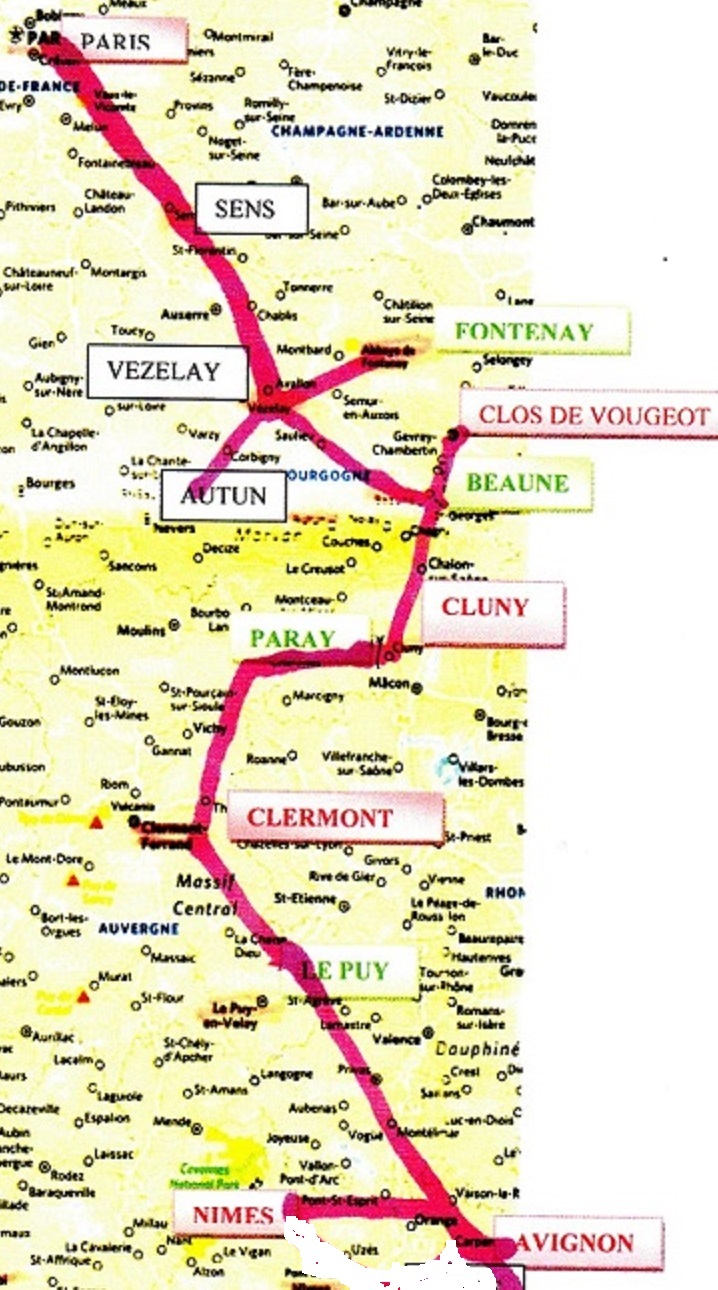
FRANCE 2012
FRANCE 2012
Day 11, Thursday, Sept 13
Avignon
We were both exhausted after such a long drive yesterday. We finally made it to the breakfast room at 9:55 – they stopped serving at 10:00, but allow us to have our breakfast. It was a large room and we were the only ones there. It was a good breakfast, more to eat than in the last few places.
We notice last night that there was a very strong wind. It was still blowing today. The wind is called a Mistral. It blows hard for several days. The sky was very sunny and bright blue but it is rather cool. I wore both my sweater and jacket.
PALACE OF POPES
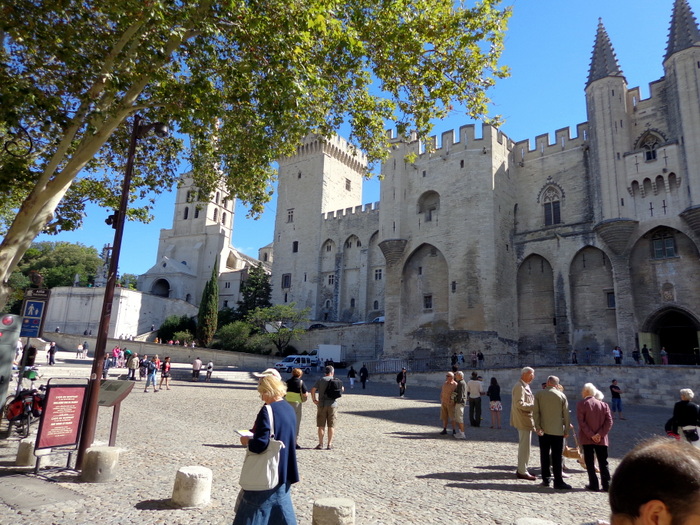 First on the agenda for today was the visit and tour of the Palace
of Popes, which is very close to our hotel. In the early 1300 there were
a lot of internal quarrels in Rome and the security of the Pope was in
danger. The archbishop of Bordeaux, who would be known at Clement V,
moved to Avignon. He appointed French Cardinals who in turn for the
next 100 years elected French Popes, who stayed in Avignon. In 1334
Benedict XII became the 3rd Avignon Pope. He built the first palace,
now known at the Old Palace. Clement VI, who was elected in 1342 built
a large addition known as the New Palace. After nine Popes in Avignon,
Gregory XI decided to go back to Rome, but things were not good. As a
result for a while there was the Western Schism with two popes – one in
Rome and one in Avignon.
First on the agenda for today was the visit and tour of the Palace
of Popes, which is very close to our hotel. In the early 1300 there were
a lot of internal quarrels in Rome and the security of the Pope was in
danger. The archbishop of Bordeaux, who would be known at Clement V,
moved to Avignon. He appointed French Cardinals who in turn for the
next 100 years elected French Popes, who stayed in Avignon. In 1334
Benedict XII became the 3rd Avignon Pope. He built the first palace,
now known at the Old Palace. Clement VI, who was elected in 1342 built
a large addition known as the New Palace. After nine Popes in Avignon,
Gregory XI decided to go back to Rome, but things were not good. As a
result for a while there was the Western Schism with two popes – one in
Rome and one in Avignon.
The palace was essentially the work of two popes, Benedict XII
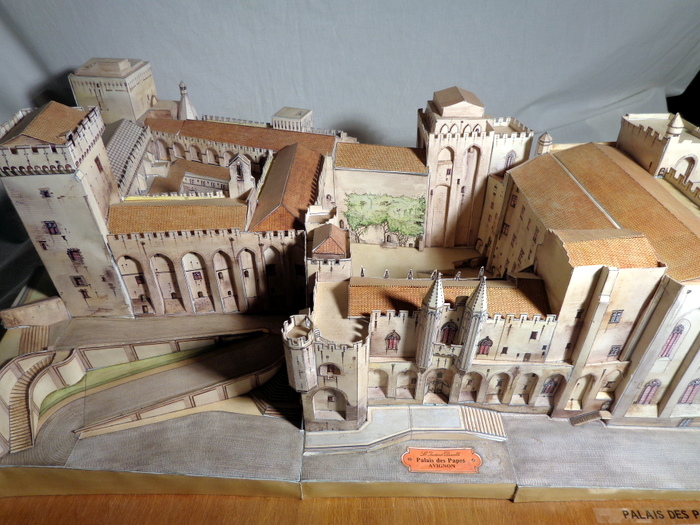 and
Clement VI, man of contrasting personalities. The first, a former monk
of Citeaux and an austere, rigid moralist build his residence like a
fortified monastery. It was of great simplicity, with no carved
ornament, unlike the Gothic architecture of the south of France. It was
influenced by the style of the Romanesque period. In there are
wooden ceilings, huge wooden panel arches and the solid peers supporting
the cloister arches are unadorned.
and
Clement VI, man of contrasting personalities. The first, a former monk
of Citeaux and an austere, rigid moralist build his residence like a
fortified monastery. It was of great simplicity, with no carved
ornament, unlike the Gothic architecture of the south of France. It was
influenced by the style of the Romanesque period. In there are
wooden ceilings, huge wooden panel arches and the solid peers supporting
the cloister arches are unadorned.
On the right is my model of the Palace of Popes. Click here for another view of the model.
The only artistic treasures of the palace of Benedict XII are its
famous frescoes, but they were the work of his successor, and Clement VI
who commissioned them in 1344. Clement
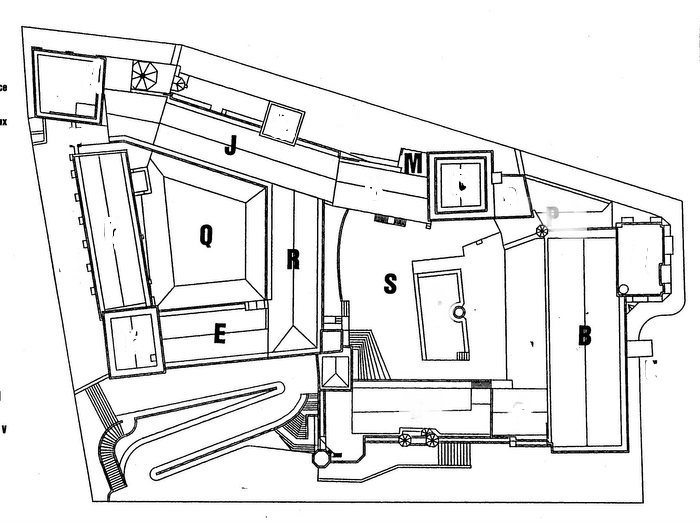 VI had engaged his master
builder from the Paris area. The work that he carried out is much closer
to the style of the northern Gothic with his predominance of stone
arches on intersecting ribs.
VI had engaged his master
builder from the Paris area. The work that he carried out is much closer
to the style of the northern Gothic with his predominance of stone
arches on intersecting ribs.
The two palaces had one feature in common and that is the impressive military fortification, which dominated the original architectural design. The building has high walls with embarkments flanked by huge towers with loopholes set in the crenellated battlements. The towers, surmounted by a fortress where the sentries kept watch, are massive pieces of stonework, divided into several floors by stone arches and wooden floors.
The tour of both the old and new Palace – ground and first floors
were fantastic. We were given audio- guides in English. Each room was
numbered and you punched in that number and heard a very good
explanation of what you were seeing. Several rooms had 3-4 minutes
films with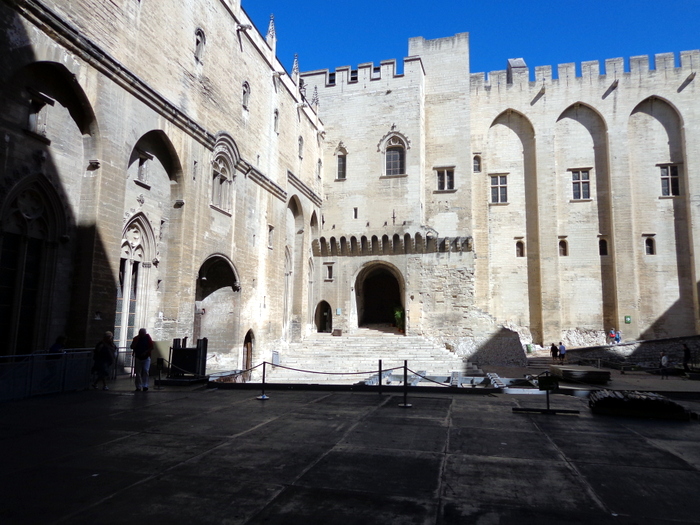 the narration coming through the audio guide. There is no
furnishing at all in the palace.
the narration coming through the audio guide. There is no
furnishing at all in the palace.
Upon entering we passed through a small room in which we bought our tickets and then out into the first courtyard known as the Court of Honor. (S on the floor plan above)
We climbed some steps and soon came to what was called the court of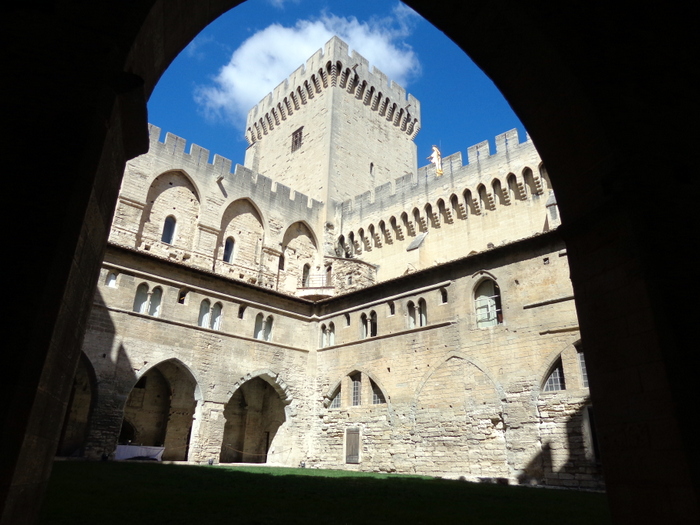 Benedict XII. (Q on the floor plan above).Buildings in this courtyard formed an irregular
quadrilateral framed by a two-story gallery, with arches supported by
massive pillars. To the north, the Benedict XII papal Chapel,
consecrated on June 20 third, 1336, was used for the great ceremonies of
the papacy. It was formed of a lower Chapel, soon converted into a store
room, and an upper Chapel covered with pointed barrel paneling
Benedict XII. (Q on the floor plan above).Buildings in this courtyard formed an irregular
quadrilateral framed by a two-story gallery, with arches supported by
massive pillars. To the north, the Benedict XII papal Chapel,
consecrated on June 20 third, 1336, was used for the great ceremonies of
the papacy. It was formed of a lower Chapel, soon converted into a store
room, and an upper Chapel covered with pointed barrel paneling
.
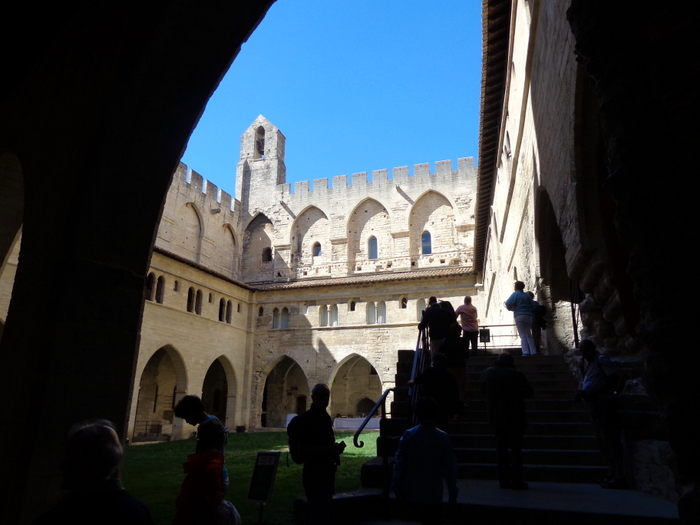
In 1352, it was replaced by the larger better expose Clementine Chapel. The Campane Tower owes its name to the small Bell tower (Campaneli) situated nearby (E on the floor plan above). The Campane Tower served as a store for arms and precious objects and house the night watchman and some members of the Papes close entourage.
The guest wing on the first floor (our second floor) contain luxurious guest departments for eminent guest.. It is currently part of the international conference Center and is close to the public.
The papal vestry,which is with in the Tour de l'Etude, housed the papal letters from the 13th and 14th centuries. The Pope vested there before the consistory meetings. The room was converted into a Chapel in the 17th century by the vice legates. The original timber work was reinforced by a stone vault which had been beautifully painted. The walls feature 17th-century wood paneling's housed the papal letters from the 13th and 14th centuries. The Pope dressed there before the Consistory meetings. (M on the floor plan above)
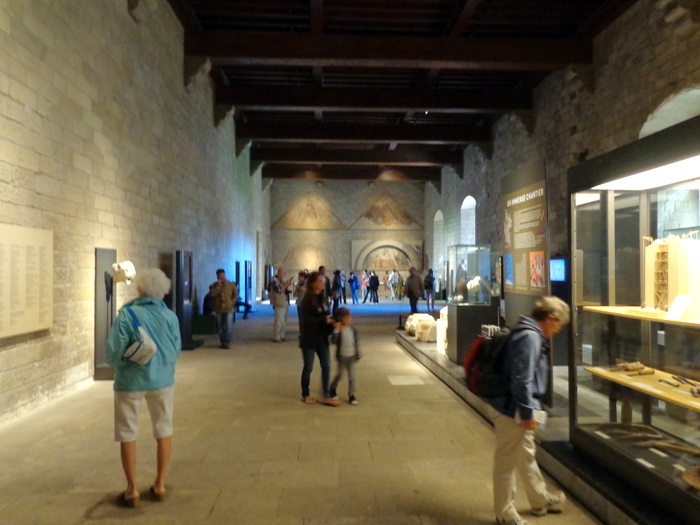 The
Consistory Hall was where the Pope convened meetings with
Cardinals; where he received the sovereigns, ambassadors or his own
legates returning from mission and where he granted public audiences.
Against the south wall stood a platform, illuminated by a small raised
window where the Pope and his ministers set. In 1413, a terrible fire
raged this building, destroying the painted declaration, of which
occasional fragments still remain here and there. (J
on the floor plan above - ground floor )
The
Consistory Hall was where the Pope convened meetings with
Cardinals; where he received the sovereigns, ambassadors or his own
legates returning from mission and where he granted public audiences.
Against the south wall stood a platform, illuminated by a small raised
window where the Pope and his ministers set. In 1413, a terrible fire
raged this building, destroying the painted declaration, of which
occasional fragments still remain here and there. (J
on the floor plan above - ground floor )
Next we stopped in a huge feast room known as the grand Tinel. (J on the floor plan above - first floor ) It measured hundred and 57 feet long. Banquets were held here on main religious feast days during the year or for the promotion of Cardinals. On average, a feast comprised five sittings of four different courses. The huge fireplace at the end of the hall was used for preparations and to keep the dishes warm.
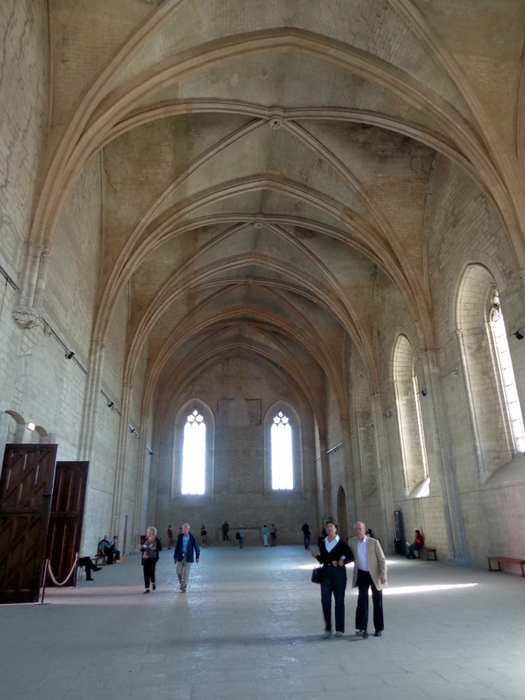 We visited the great Clementine Chapel. From 1344 to 1347, Clement
VI bought several buildings that were demolished to make room for the
new Palace.The Pope build a new papal Chapel on the first floor. Work
on the Clementine Chapel took four years; it was slow down by the black
death of 1348. The Chapel, dedicated to Peter and Paul, offered a
sumptuous setting for the solemn mass is celebrated in the presence of
the Pope, or for Carnation ceremonies are funerals. It has seven bays
with rib vaulting. (B on floor plan above )
We visited the great Clementine Chapel. From 1344 to 1347, Clement
VI bought several buildings that were demolished to make room for the
new Palace.The Pope build a new papal Chapel on the first floor. Work
on the Clementine Chapel took four years; it was slow down by the black
death of 1348. The Chapel, dedicated to Peter and Paul, offered a
sumptuous setting for the solemn mass is celebrated in the presence of
the Pope, or for Carnation ceremonies are funerals. It has seven bays
with rib vaulting. (B on floor plan above )
At the conclusion of the tour, we descended a very long and very steep staircase that led to a large and beautiful gift shop where we purchased several items.
We were at the Papal Palace for two hours. There was a lot of up and down stairs- many without railings. From our experience at Le Puy Cathedral (see yesterday) and the Palace of Popes, I would recommend senior citizen planning our trip should practice walking up and down steps without holding on for at least a half hour every day for a year. However, we have seen a lot of more senior folks than us making it – canes and all. I made a model of the Palais du Papes several years before. After the Popes finally left, The Place was used as a prison.
There is a very large town square not far from the Pala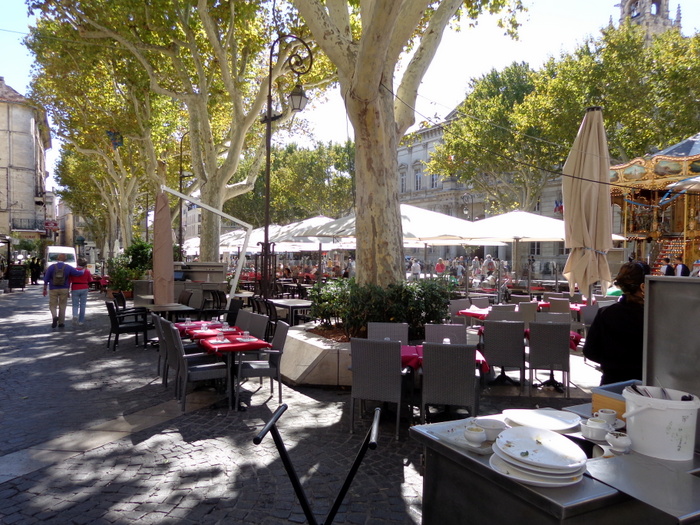 ce and our
hotel. There are rows and rows of café tables in the middle of the
square. We just picked one for lunch. I had a Croque Monsieur (a
grilled ham and cheese) and Kathleen had quiche.
ce and our
hotel. There are rows and rows of café tables in the middle of the
square. We just picked one for lunch. I had a Croque Monsieur (a
grilled ham and cheese) and Kathleen had quiche.
On the other side of our hotel is the famous Pont d’Avignon (the
Avignon Bridge) that was built in 1177. In the 17th century a flood
destroyed part
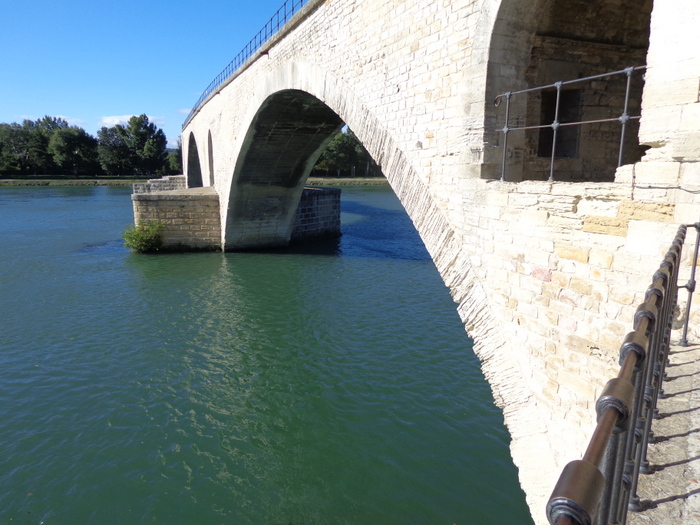 of it. Some of you may remember the French song lyric -
“Sur le pont d'Avignon l'on y danse tout en rond” That’s the bridge.
You can walk all the way to the end. I did but Kathleen just walked a
little bit. The wind was very strong.
of it. Some of you may remember the French song lyric -
“Sur le pont d'Avignon l'on y danse tout en rond” That’s the bridge.
You can walk all the way to the end. I did but Kathleen just walked a
little bit. The wind was very strong.
Looking back from the end of the bridge, there is beautiful view of the Palace of Popes.
From there we went up on the Ramparts of the wall. From the Ramparts there is a wonderful view of the Pont d'Avignon.
We went back to the hotel and had a drink in the bar .
We had reservations in a restaurant called – La Fourchette. It was just several blocks from the hotel. Our neighbors, who had been to Avignon recently, recommended it. It was a small place with about 20 tables, but the service was terrible. It was full except for a 6 seating and a 4 seating. We sat for almost half hour before we received the menu. Everything was slow. The 6 table and 4 came about 9:00 and were served almost immediately. Our meals were wonderful, but unfortunately for all of us, the restaurant was “slammed”, by too many folks arriving at the same time. For starter, I had tomato and mozzarella, French style and Kathleen had eggplant with red peppers. For dinner Kathleen had cod fish with leaks, and I had scallops. It was a delicious dinner but far too slow. At the end of the meal, the waiter did not bring the bill, so we knew that he had given up. We walked to the bar and the owner gave us the bill. She knew that it had been a tough night.
NEXT DAY
Day 1 - Paris
Day 2 - Sens
Day 3 - Vezelay
Day 4 - Abbey Fontenay, Semur-en-Auxois,
Vezelay -
Day 5 - Beaune
Day 6 - Beaune, Autun, Citeaux, Chateau du
Clos Vougeot-
Day 7 - Cluny
Day 8 - Cluny
Day 9 - Paray-le-Monial and Clermont-Ferrard
Day 10 - Le Puy-en-Velay
Day 11 - Avignon
Day 12 - Avignon to Nimes
Day 13 - Avignon
Day 14 - Marseille
Day 15 - Marseille
Day 16 - Marseille
Day 17 - Marseille to Aigues-Mortes
Day 18 - Carcassonne
Day 19 - Carcassonne to Toulouse (posted 10/6/15)
Day 20 - Toulouse
Day 21 - Albi
Day 22 - Toulouse
